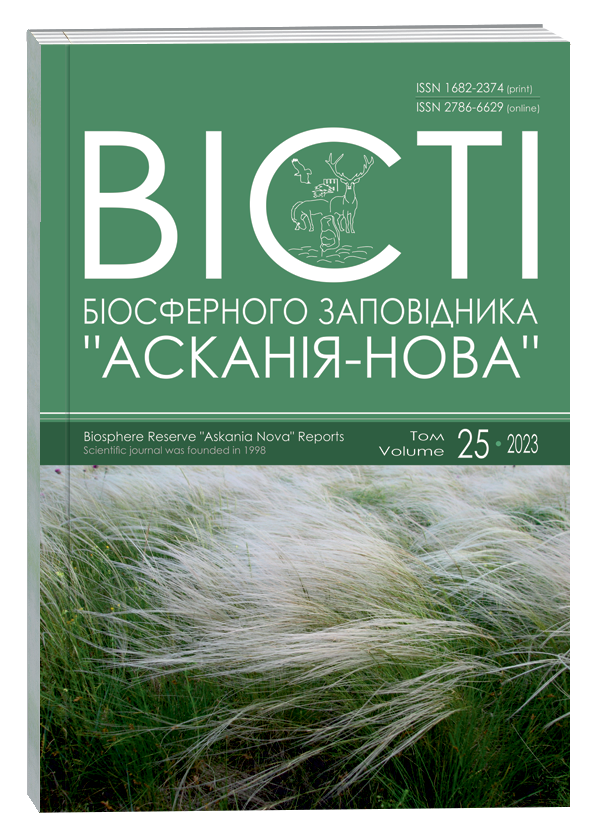MORPHO-STRUCTURAL TRANSFORMATIONS OF THE ROOT SYSTEM OF SPECIES OF THE GENUS SEDUM L. DURING SEASONAL DEVELOPMENT IN THE CONDITIONS OF THE STEPPE ZONE OF UKRAINE (ON THE EXAMPLE OF KRYVORIZHYA)
DOI:
https://doi.org/10.53904/1682-2374/2023-25/6Keywords:
Архітектура кореневої системи, живильна і ростова частина, додаткові, бічні та контрактильні корені, Sedum L.Abstract
Peculiarity of the formation of the root system of species of the genus Sedum during seasonal development in the climatic conditions of Kryvorizhya are presented. The of the root system of plants served as research material S. aizoon, S. album, S. reflexum and S. spurium. The research was conducted in the Kryvyi Rih Botanical Garden of the NAS of Ukraine, the natural and climatic conditions of which are characterized by parameters common to the steppe zone, which limit the growth of plants – lack of moisture in the air and soil, abnormally high summer air temperatures. Peculiarities of the location of the root system along the soil horizons were explored taking into account the character of the physiological functions of the roots – the growth and nourishing part. The length of additional and contractile roots, the intensity of branching of lateral roots were determined. During seasonal development of plant of S. album, S. reflexum, S. spurium and S. aizoon was marked the increase of amount of nourishing roots – additional and lateral on them, which in the phase of completion of forming of superficial vegetative sphere (May) branch out to the second order, while in the phase of completion of vegetation (October) – to the third. At the end of the active sea-sonal development in plants S. album, S. reflexum the nutrient part of the root system is disposed is nearer to the surface and reach a wide lateral extension. In plants of S. spurium the nourishing roots deepen in the soil, in S. aizoon they do not change their location. The development of the growth part of the root system was marked by an increase the length of anchor and contractile roots, a slight in-crease in their number and a deepening in of the soil. The main volume of nourishing roots (up to 65%) has a lateral location in the upper layer of the soil 0–10 cm, except S. spurium for plants which it is a layer of soil 0–15 to 20 cm. The roots performing mechanical functions in the studied species reach a depth of 20–30 cm, and only in S. reflexum these roots grow to a depth of 15 cm. Additional roots in S. album, S. reflexum and S. spurium are formed in the internodes of plagiotropic ground shoots, which subsequently function as rhizomes. S. aizoon is characterized by the regrowth of addi-tional roots only in the basal part of vegetative shoots, which prevents the active spread of plants.
References
Березкіна В. І. Біологічні особливості інтродукованих видів роду Sedum L. (Crassulaceae DC.) та перспективи їх використання в Україні : автореф. дис. … канд. біол. наук : 03.00.05. Київ, 2003. 21 с. Бордзиловський Є. І. Рід очиток – Sedum L. Флора УРСР. Т. 5 / ред. Клоков М. В. Київ : Вид-во АН УРСР, 1953. C. 454–467.
Войтюк Ю. О., Кучерява Л. Ф., Баданіна В. А., Брайон О. В. Морфологія рослин з основами анатомії та цитоембріології. Київ : Фітосоціоцентр, 1998. 216 с.
Дідух Я. П. Екологічні аспекти глобальних змін клімату: Причини, наслідки, дії. Вісник НАН України. 2009. № 2. С. 34–44.
Довідник з морфології квіткових рослин. Навчально-методичний посібник. / Зиман С. М., Мосякін С. Л., Булах О. В., Царенко О. М., Фельбаба-Клушина Л. М. Ужгород : Медіум, 2004. 156 с.
Приходько М. М. Екологічна безпека природних і антропогенно модифікованих геосистем: монографія. Київ : Центр екологічної освіти та інформації, 2013. 201 с.
Пушка І. М., Величко Ю. А., Осіпов М. Ю., Козаченко І. В. Еколого-біологічні особливості інтродукованих видів роду Sedum L. в умовах Правобережного Лісостепу України. Таврійський науковий вісник. 2019. № 109. Ч. 1. С. 212–218. https://doi.org/10.32851/2226-0099.2019.109-1.31
Єгоршин О. О., Лісовий М. В. Математичне планування польових дослідів та статистична обробка експериментальних даних. Харків : Вид-во Ін-ту грунтознавства та агрохімії ім. О.Н. Соколовського, 2005. 193 с.
Єремеєв В., Єфімов В. Регіональні аспекти глобальної зміни клімату. Вісник HAH України. 2003. № 2. С. 24–28. http://dspace.nbuv.gov.ua/handle/123456789/70185.
Лихолат Ю. В., Хромих Н. О., Дідур О. О., Оковитий С. І., Матюха В. Л., Савосько В. М., Лихолат Т. Й. Сучасний стан антропогенної трансформації екосистем степового Придніпровʹя. Кривий Ріг : Вид-во Чернявський Д., 2019. 146 с.
Паранько І. С., Казаков В. Л., Калініченко О. О., Коцюруба В. В., Остапчук І. О., Савосько В. М., Шипунова В. О., Ярков С. В. Фізична географія Криворіжжя : монографічна навчальна книга. Кривий Ріг : Вид. Р.А. Козлов, 2015. 272 с.
Anjum S. A., Xie X.-Y., Wang L.-C., Saleem M. F., Man Ch., Lei W. Morphological, physiological and biochemical responses of plants to drought stress. African Journal of Agricultural Research. 2011. Vol. 6(9). Р. 2026–2032. https://doi.org/10.5897/AJAR10.027
Bano Ch., Amist N., Singh N. B. Morphological and anatomical modifications of plants for environmental stresses. In: A. Roychoudhury & D. Tripathi (ed). Molecular plant abiotic stress: Biology and biotechnology. John Wiley & Sons, Ltd. 2019. ch. 2. Р. 29–45. https://doi.org/10.1002/9781119463665.ch2
Bramwell D. Plant adaption and climate change. 2nd World Scientific Congress Challenges in Botanical Research and Climate Change : programmer Book of abstract, 29 June – 4 July, 2008. Delft, The Netherlands. Р. 3.
Butler C., Orians C. M. Sedum cools soil and can improve neighboring plant performance during water deficit on a green roof. Ecological Engineering. 2011. Vol. 37(11). Р. 1796–1803. https://doi.org/10.1016/j.ecoleng.2011.06.025
Comas L. H., Becker S. R., Cruz V. M., Byrne P. F., Dierig D. A. Root traits contributing to plant productivity under drought. Front. Plant Sci. 2013. Vol. 4. Р. 442. https://doi.org/10.3389/ fpls.2013.00442
De Micco V. & Aronne, G. Morpho-anatomical traits for plant adaptation to drought. In: Aroca, R. (ed). Plant Responses to Drought Stress. Springer, Berlin, Heidelberg. 2012. Р. 37–61. https://doi.org/ 10.1007/978-3-642-32653-0_2
Franklin K. A. Light and temperature signal crosstalk in plant development. Curr. Opin. Plant Biol. 2009. Vol. 12 (1). Р. 63–68. https://doi.org/10.1016/j.pbi.2008.09.007 Garofalo P., Ventrella D., Kersebaum K. C., Gobin A., Trnka M., Giglio L., Dubrovský M., Castellini M. Water footprint of winter wheat under climate change: Trends and uncertainties associated to the ensemble of crop models. Science of the Total Environment. 2019. Vol. 658. Р. 1186–1208. https://doi.org/10.1016/j.scitotenv.2018.12.279 Gray S. B., Brady S. M. Plant developmental responses to climate change. Developmental Biology. 2016. Vol. 419. Р. 64–77. https://doi.org/10.1016/j.ydbio.2016.07.023
Hart H., Bleij B. Sedum. Illustrated handbook of succulent plants: Crassulaceae / ed. Eggli U. Berlin, Heidelberg & New York : Springer, 2003. P. 235–332.
Heckathorn S. A., Giri A., Mishra S., Bista D. Heat stress and roots: Climate change and plant abiotic stress tolerance. Weinheim : Wiley-VCH Verlag GmbH & Co. 2013. P. 109–136. https://doi.org/10.1002/9783527675265.ch05 Jung H.-J., Kang H.-J., Song Y. S. Park E.-H., Kim Y.-M., Lim C.-J. Anti-inflammatory, anti-angiogenic and anti-nociceptive activities of Sedum sarmentosum extract. Journal of Ethnopharmacology. 2008. Vol. 116(1). Р. 138–143. https://doi.org/10.1016/j.jep.2007.11.014
Klimešová J., Vintrlíková E., Středa T. Adaptation strategies to climate change – the plant roots. Towards Climatic Services Nitra, Slovakia, 15th – 18th September, 2015. Р. 179–181. Lu J., Yuan J.-g., Yang J.-z., Yang Z. Responses of morphology and drought tolerance of Sedum lineare to watering regime in green roof system: A root perspective. Urban Forestry & Urban Greening. 2014. Vol. 13(4). Р. 682–688. https://doi.org/10.1016/j.ufug.2014.08.003 Schenk H. J., Jackson R. B. Rooting depths, lateral root spreads and below-ground/above-ground allometries of plants in water-limited ecosystems. Journal of Ecology. 2002. Vol. 90(90). Р. 480–494. https://doi.org/10.1046/j.1365-2745.2002.00682.x The Leipzig catalogue of vascular plants. German Centre for Integrative Biodiversity Research (iDiv) Halle-Jena-Leipzig. 2020 Electronic resource, URL: https://doi.org/10.15468/9qxmn3 [1/11/2022]
Wahid A., Gelani S., Ashraf M., Foolad M. R. Heat tolerance in plants: an overview. Environmental and Experimental Botany. 2007. Vol. 61. Р. 199–223. https://doi.org/10.1016/j.envexpbot.2007.05.011 Weather forecast web-site: Electronic resource, URL: http://rp5.ua [10/12/2022].
Weiser M., Koubek T., Herben T. Root foraging performance and life-history traits. Front. Plant. Sci. 2016. Vol. 7. Р. 779. https://doi.org/10.3389/fpls.2016.00779







